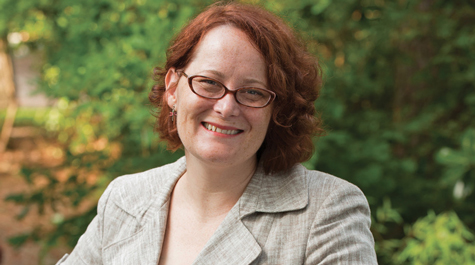W&M physicist elected co-spokesperson for NOvA neutrino experiment
Fermilab’s forefront neutrino experiment gains a new and experienced leader as it prepares for its future collecting more neutrino data for analysis.
Tricia Vahle, professor of physics at William & Mary and longtime NOvA leader and scientist, was elected as NOvA’s new co-spokesperson in 2018 and assumed her role on March 21. Christopher Carone, chair of the university’s Department of Physics, said that Vahle steps into a high-visibility role that will also increase the status of the institution.
“This is a prestigious leadership position on an important large-scale particle physics experiment, one that will give William & Mary significant visibility in the high-energy physics community,” he said.
The NOvA experiment itself is a large collaboration, with 242 scientists representing 49 institutions across seven countries. To study properties of mysterious particles known as neutrinos, NOvA sends a beam of the particles from Fermilab outside of Chicago to a far detector in Northern Minnesota.
Neutrinos fly through space — and just about anything else in their way — at almost light speed. They come in three “flavors,” and change from one flavor into another. This change act is called oscillation and NOvA aims to measure this behavior with great precision, looking closely at both neutrinos and their antimatter counterparts, called antineutrinos.
In her new role, she will meet with a wide range of stakeholders in the NOvA experiment. Vahle said that her contact will range from fellow Fermilab scientists to makers of scientific policy.
“The spokespeople are the public face of the experiment. They advocate for the collaboration within the funding agencies — the Department of Energy and the National Science Foundation,” Vahle explained. “They also work within Fermilab, to make sure that NOvA has what it needs to do the physics that it needs to do.”
Vahle has served as the public face of NOvA in the past, most notably when she was selected to explain the goals and challenges of the experiment in a 2012 video.
She said her new position will come with a different set of challenges in communicating with each group of NOvA stakeholders. She added that she has seen scientists as a community becoming more skilled and successful at communicating complex ideas to the lay public without resorting to mathematical explanations and jargon.
Vahle said that she devotes considerable thought to her presentations, particularly to “really busy people” such as officeholders. It’s a tall order, as NOvA is one of the world’s leading investigation into the mysterious, superabundant subatomic particles.
“For example: Why do we care so much about θ13, this obscure Greek-letter thing that needs subscripts?,” she said, referring to a value related to neutrino change. “Why is that particular quantity so important? Why should we spend resources on it?”
Vahle has worked on NOvA for about 10 years, since before the experiment was built in 2014. She was instrumental in NOvA’s early years as one of the founders of a NOvA data analysis group. Later she became NOvA’s analysis coordinator, overseeing different analysis teams.
She is one of four members of the NOvA experiment from the Department of Physics at William & Mary. The others are postdoctoral researcher Alex Radovic, and Professor Jeff Nelson and his graduate student Marco Colo. They often involve William & Mary undergraduates, and this summer three undergraduates will join Vahle to work on NOvA.
She will join current spokesperson Peter Shanahan, who played a major role in completing NOvA’s construction on time and under budget and taking it into its data collection and analysis phase. Vahle succeeds former co-spokesperson Mark Messier of Indiana University, who served the experiment and neutrino community for over 12 years.
“Tricia has a huge amount of experience on NOvA, and with neutrino physics in general,” Shanahan said. “She’s been working on NOvA for many years and has a good sense of both organizational and scientific aspects of leading such an experiment.”
After four years of taking data on neutrinos, NOvA recently shifted to recording data on antineutrinos. The comparison of neutrinos to antineutrinos could reveal new physics.
“It’s a very exciting time because we’re on the verge of realizing NOvA’s full physics potential,” Vahle said. “We’re looking forward to using more sensitive data analyses to study both antineutrinos and neutrinos and compare them.”
NOvA will continue to run until 2024, switching between antineutrino and neutrino data collection to obtain roughly equal amounts of data for each. NOvA will also focus on making ever more precise measurements of neutrinos’ basic properties.
“My goal in the near future is to work together with Tricia to get more NOvA data and to make the most of it,” Shanahan said. “We can face the challenge of more clearly understanding properties of neutrinos by collecting more data and improving our analysis.”
“In the long-term, we aim to keep people excited about our experiment and the top-notch physics we are doing,” Vahle said.
 Skip to main content
Skip to main content

